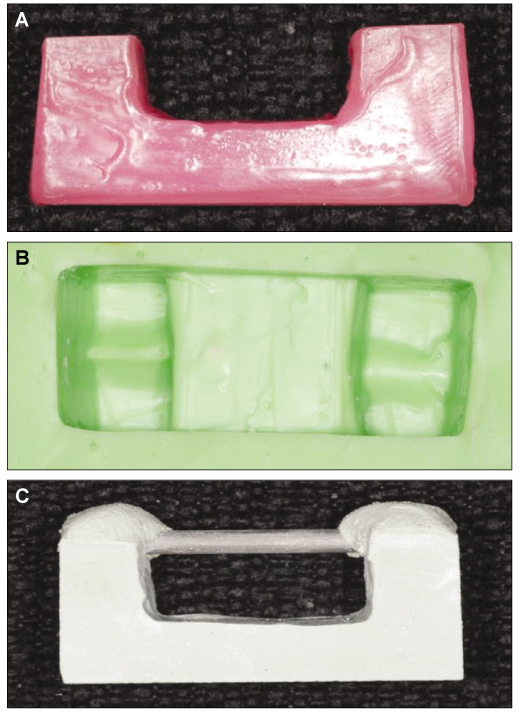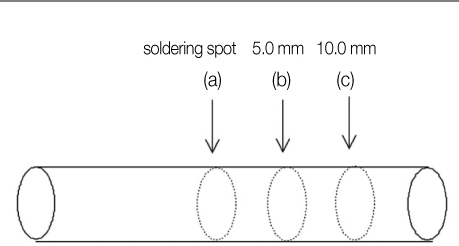J Korean Acad Prosthodont.
2012 Jan;50(1):53-60.
Study on the effect of soldering methods on the characteristics of the Ni-Cr alloy
- Affiliations
-
- 1Department of Prosthodontics, School of Dentistry, Dankook University, Cheonan, Korea. hyuk928@chol.com
Abstract
- PURPOSE
The purpose of this study was to compare Ni-Cr alloy property of gas-oxygen torch soldering and infrared welding using optical microscope and Electron Probe Micro Analyzer (EPMA).
MATERIALS AND METHODS
Ni-Cr alloys were casted for specimens. Specimens had 3.0 mm diameter, 30.0 mm length and were divided into two groups. Each group had 4 specimens. One group was for gas-oxygen torch soldering and the other was infrared welding. Specimens were cut with low-speed disc and soldered each other with gas-oxygen torch and infrared machine. After soldering and polishing, specimens were observed at 3 points (soldering point, 5 mm distance point, 10 mm distance point) with optical microscope and analyzed 3 points (soldering point, 5 mm distance point, 10 mm distance point with EPMA.
RESULTS
The results of this study were as follows: 1. The observation of gas-oxygen torch soldering at 10 mm distance point under the optical microscope was not founded any specific surface properties, but some crack lines were observed at 5 mm distance and soldering point. 2. There were no crack lines were founded at the observation of infrared welding at 10 mm distance and 5 mm distance points under the optical microscope. However, at the 5 mm distance, the surface was not smooth enough compared with at 10 mm distance point. Some crack lines were observed at the welding point as well. 3. In the EPMA analysis of the gas-oxygen torch soldering, the component of Ni was increased by 4.5%, Cr was increased by 7.5% than that of the Ni-Cr alloy at the 10.0 mm distance. At the 5 mm distance, the component of Ni was decreased by 6.1%, Mo was increased by 9.0% than that of the Ni-Cr alloy but Cr was equally shown at the 5.0 mm distance. Only Ni was shown at the soldering point. 4. In the EPMA analysis of the infrared welding, the component of Ni was increased by 9.1%, Cr was increased by 0.4% than that of the Ni-Cr alloy but Al was equal at the 10.0 mm distance. At the 5 mm distance, the component of Ni was increased by 4.7%, Cr was increased by 4.7% and Al was increased by 0.1% than that of the Ni-Cr alloy. At the welding point, the component of Ni was increased by 8.8%, Cr was increased by 8.2% than that of the Ni-Cr alloy.
CONCLUSION
From these results, at the 5 mm distance from the soldering point, the surface of the infrared welding was more smoother than that of the gas-oxygen torch soldering. On the EPMA analysis, the component of the specimens with infrared welding was more similar than that of the gas-oxygen torch soldering compared with the component of the Ni-Cr alloy.
Figure
Reference
-
1. Lorenzana RE, Staffanou RS, Marker VA, Okabe T. Strength properties of soldered joints for a gold-palladium alloy and a palladium alloy. J Prosthet Dent. 1987. 57:450–454.
Article2. Bergman M. Combinations of gold alloys in soldered joints. Swed Dent J. 1977. 1:99–106.3. Lanin VL. Infrared heating in the technology of soldering components in electronics. Surf Engineer Appl Electrochem. 2007. 43:381–386.
Article4. Bellagamba RL. The effects of prewetting on postsoldering of base metal alloys. J Prosthet Dent. 1985. 54:355–358.
Article5. Tambasco J, Anthony T, Sandven O. Laser welding in the dental laboratory: an alternative to soldering. J Dent Technol. 1996. 13:23–31.6. Townsend LW, Vermilyea SG, Griswold WH. Soldering nonnoble alloys. J Prosthet Dent. 1983. 50:51–53.
Article7. Stade EH, Reisbick MH, Preston JD. Preceramic and postceramic solder joints. J Prosthet Dent. 1975. 34:527–532.
Article8. Bernard C, Moon PC, Knap F. Strength of PFM solder connectors, with and without gold plating. J Dent Res. 1982. 61:245–248.9. Sobieralski JA, Brukl CE, Smith NK. Tensile strengths and microscopic analysis of nickel-chromium base metal postceramic solder joints. J Prosthet Dent. 1987. 58:35–42.
Article10. Cattaneo G, Wagnild G, Marshall G, Watanabe L. Comparison of tensile strength of solder joints by infrared and conventional torch technique. J Prosthet Dent. 1992. 68:33–37.
Article11. Monday JJ, Asgar K. Tensile strength comparison of presoldered and postsoldered joints. J Prosthet Dent. 1986. 55:23–27.
Article12. Tehini GE, Stein RS. Comparative analysis of two techniques for soldered connectors. J Prosthet Dent. 1993. 69:16–19.
Article13. Lee SY, Lee JH. Effect of soldering techniques and gap distance on tensile strength of soldered Ni-Cr alloy joint. J Adv Prosthodont. 2010. 2:117–121.
Article14. Chai T, Chou CK. Mechanical properties of laser-welded cast titanium joints under different conditions. J Prosthet Dent. 1998. 79:477–483.
Article15. Lancaster JF. Metallurgy of welding. 1993. 5th ed. London: Chapman and Hall.
- Full Text Links
- Actions
-
Cited
- CITED
-
- Close
- Share
- Similar articles
-
- Effect of soldering techniques and gap distance on tensile strength of soldered Ni-Cr alloy joint
- The study of tension characteristics in orthodontic wires
- Surface roughness changes caused by the galvanic corrosion between a titanium abutment and base metal alloy
- SHEAR BOND STRENGTH OF RESIN ADHESIVE CEMENT TO ENAMEL AND Ni-Cr-Be ALLOY
- A study on surface roughness of metals according to finishing and polishing procedures: an atomic force microscope analysis










